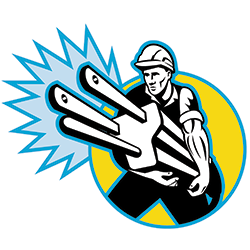flooring
 I just purchased new flooring for several of my exhibits, and I want to make sure it lasts as long as possible. How can I extend the life of my flooring? I just purchased new flooring for several of my exhibits, and I want to make sure it lasts as long as possible. How can I extend the life of my flooring?
 Most exhibit managers try to extend the life of their exhibitry and graphics via careful packing and ongoing maintenance, but many overlook a critical exhibit element under their feet: their flooring. Granted, exhibit flooring probably isn't the largest line-item expense in your program, but it's certainly a sizeable investment that's worth protecting. Most exhibit managers try to extend the life of their exhibitry and graphics via careful packing and ongoing maintenance, but many overlook a critical exhibit element under their feet: their flooring. Granted, exhibit flooring probably isn't the largest line-item expense in your program, but it's certainly a sizeable investment that's worth protecting.
And believe it or not, the steps
required to ensure your flooring lasts as long as possible - and looks as good as it can during its lifetime - don't require a lot of extra time, money, or planning. You just need a bit of knowledge to help you prevent problems along the way. Here are eight easy ways to maximize the life-span of your underfoot investment.
1. Roll pliable flooring around its original core. If your carpet, vinyl, faux turf, etc. were shipped to your supplier wrapped around a heavy cardboard core, you need to retain this core for shipping and storage.
The core keeps the flooring taut and smooth, therefore preventing creasing, cracking, etc. The core is especially useful in protecting the ends of your carpet. If you roll the flooring into a coil without wrapping it around a firm core, you risk damaging the first several feet in that coil, which, over time, will eventually crack - or simply look "smashed."
2. Palletize rolled flooring. Flooring that's purchased and shipped on a roll should be palletized as well, even if it's a 10-foot-long roll. (You can typically purchase a 10-foot-long pallet from a flooring provider.) By strapping the flooring roll to the pallet, you'll ensure that the carpet is stable and secure inside the transport vehicle, as opposed to rolling around and possibly damaging its outer layer and other items in the trailer. But
perhaps more importantly, the pallet
helps decrease the chances of a forklift either damaging the exterior of the flooring as the operator tries to pick it up, or skewering it completely by trying, often unsuccessfully, to force the forklift tongs under the unpalletized roll. With a pallet, the operator can slide the forklift arms safely under the pallet and transport the carpet wherever necessary.
Granted, adding flooring pallets to your shipment will increase its weight and therefore, your shipping and drayage costs. However, the added costs are probably less than the cost of an entire roll of skewered flooring.
3. Protect carpet backing. Unbeknownst to most exhibitors, the process of taping down and pulling up flooring often results in flooring damage. As you dismantle your booth and pull up the flooring, a thin layer of the flooring's backing usually stays stuck to the tape. So with every show you attend, a layer of your backing is stripped away - eventually to the point that the backing disintegrates beyond repair. The solution is to attach a 2- to 3-inch strip of clear tape around every edge of your flooring. Compared to the rough surfaces of traditional flooring backing, the smooth, clear tape allows the flooring tape to release easily.
Don't let the flooring installers try to tell you that they use low-release tape that won't damage carpeting. The tape might release well in other situations, but after three to five days of constant foot traffic, even this tape creates a tight bond with the show floor and the back of your flooring. And when your flooring is ripped off the floor, you're bound to lose at least some of your backing.
4. Don't extend padding to the edge. Always leave roughly 3 inches between the edge of any padding and the outer edge of the flooring. This allows the installation-and-dismantle crew plenty of room to tape down the flooring directly to the venue's floor. If the padding extends all the way to the edge of the flooring, workers will likely hack away at it to reveal enough area underneath to securely tape down your flooring - not only chipping away at your padding investment but often making an uneven cut in your padding that makes for more time consuming (and money draining) installations going forward.
5. Cross cut carpet and vinyl. Invariably, you'll need to cut holes in your rolled flooring to allow wiring to pass through it. But rather than cutting a circular hole in the flooring, make sure your I&D crew cuts an X into it and slips the wiring through it. Granted, this doesn't do anything to protect or maintain the flooring. But if you should ever choose to move your wiring-access points, you'll be able to tape up the X-shaped cuts from the reverse side of your flooring to create an almost invisible seam, allowing you to reuse the flooring as opposed to trashing it.
6. Clean carefully. Nobody wants to unroll their flooring at the beginning of a show only to find it stained and dirty. So a bit of cleaning and stain removal should be one of the last steps you perform before you bid your flooring adieu at the end of a show. But departing exhibitors are often in a rush to get out of the exhibit hall and home to friends and family, which means they'll likely grab just about anything to try to remove that coffee stain.
However, spot cleaning should only be done with a supplier-approved cleaner so as not to discolor the flooring. But if those staffers or exhibit managers grab that bottle of anything - perhaps one that contains bleach or some other substance that can discolor various materials - they'll create an unsightly and permanent spot that while clean is certainly unsightly. So whether your flooring is wood, vinyl, foam, carpet, etc., ask your supplier how to clean it and make sure this cleaner and appropriate cleaning tools and supplies are shipped with the exhibit and that staffers know exactly how to use them.
7. Cover it in Visqueen. Most exhibitors
are smart enough to protect their flooring with Visqueen (an inexpensive plastic-like material) between the time the flooring is placed in the booth space and when the show opens. However, when it's time to dismantle the exhibit and head home, flooring protection isn't exactly top of mind - and that protective layer of Visqueen rarely gets applied a second time. The same dirty machinery whizzing around the exhibit hall during setup is also present during teardown, and you certainly don't want your carpet arriving at your next show with a big forklift tire track running across one corner. So to avoid the tired-looking tire tracks, take the time - and make the minor investment - to cover your exhibit flooring with Visqueen during teardown as well as setup.
8. Monitor the dismantle of interlocking
floor systems. Just about any kind of interlocking flooring system - be it tile, foam, wood, etc. - goes down quickly and easily. But when laborers remove these floors, they often hastily pull them up, which can damage their locking mechanisms, whether you've got puzzle-piece-like edging,
installation clips, special locking devices, etc. By simply instructing the teardown crew to carefully remove the flooring - and monitoring them while they do so - you can ensure that your interlocking flooring comes up as safely and easily as it went down.
As you can see, extending the life of your flooring isn't as difficult or time consuming as one might think. All you need is a bit of knowledge and a few spare minutes, and your new flooring will retain its youthful appearance well into the future.
- Tim Morvay, president,
Trade Show Flooring Direct,
Crystal Lake, IL
|






 I just purchased new flooring for several of my exhibits, and I want to make sure it lasts as long as possible. How can I extend the life of my flooring?
I just purchased new flooring for several of my exhibits, and I want to make sure it lasts as long as possible. How can I extend the life of my flooring? Most exhibit managers try to extend the life of their exhibitry and graphics via careful packing and ongoing maintenance, but many overlook a critical exhibit element under their feet: their flooring. Granted, exhibit flooring probably isn't the largest line-item expense in your program, but it's certainly a sizeable investment that's worth protecting.
Most exhibit managers try to extend the life of their exhibitry and graphics via careful packing and ongoing maintenance, but many overlook a critical exhibit element under their feet: their flooring. Granted, exhibit flooring probably isn't the largest line-item expense in your program, but it's certainly a sizeable investment that's worth protecting.


